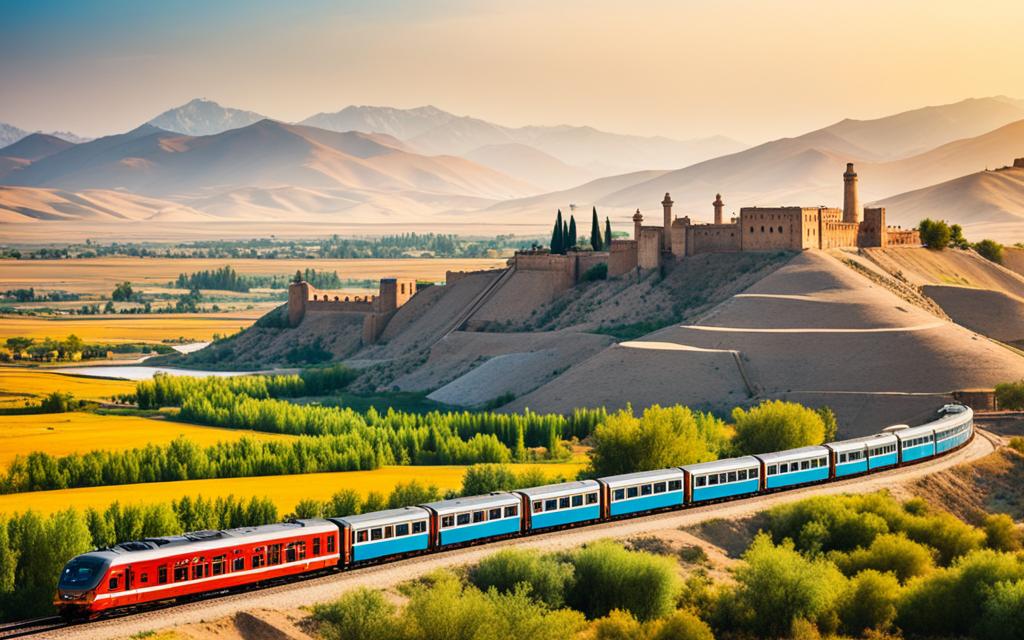Did you know that the Silk Road was not just a trade route, but a network of trade routes spanning over 7,000 miles? This ancient road connected East and West, creating cultural exchanges and shaping the world we know today. And one of the most enchanting parts of the Silk Road journey is the Uzbekistan railway route.
Embark on a mesmerising adventure through the heart of Uzbekistan, following in the footsteps of ancient traders and explorers. Discover the architectural wonders, vibrant culture, and rich history of this Central Asian gem. In this article, we will provide you with captivating holiday ideas to make your trip along the Silk Road unforgettable.
Key Takeaways
- Explore the ancient Silk Road cities in Uzbekistan, each with its own unique architectural wonders and cultural heritage.
- Samarkand, a renowned city along the Silk Road, was a hub of commercial activities and cultural exchange.
- Immerse yourself in the vibrant culture of Uzbekistan, from its diverse traditions to its exquisite cuisine.
- Don’t miss out on visiting must-see sites along the Silk Road in Uzbekistan, from ancient cities to breathtaking landscapes.
- Start planning your railway holiday and uncover the wonders of the Silk Road in Uzbekistan.
Exploring Ancient Silk Road Cities in Uzbekistan
One of the highlights of the Silk route railway journey in Uzbekistan is the opportunity to explore its ancient cities. These cities played a crucial role in the Silk Road trade route, facilitating the exchange of goods, culture, and ideas. Today, they stand as a testament to the rich history and heritage of Uzbekistan.
Among the ancient Silk Road cities in modern Uzbekistan, there are a few that stand out for their architectural wonders and cultural significance:
Samarkand
Samarkand, known as the “Pearl of the Silk Road,” is a UNESCO World Heritage Site and one of the oldest inhabited cities in Central Asia. Its awe-inspiring landmarks, such as the Registan Square and the Bibi-Khanym Mosque, showcase the grandeur of Islamic architecture during the Timurid dynasty. The city’s vibrant history and mesmerising beauty make it a must-visit destination for any Silk Road enthusiast.
Bukhara
Bukhara is another ancient city that flourished during the Silk Road era. Its well-preserved old town, with its labyrinthine streets and beautiful architecture, takes you back in time. The Ark of Bukhara, a fortified residence of the emirs, and the Kalon Minaret are just a glimpse of the city’s rich past. The vibrant bazaars and charming teahouses also provide opportunities to immerse yourself in the local culture and traditions.
Khiva
Khiva, a city located on the western edge of Uzbekistan, is like stepping into a living museum. Its ancient city walls, well-preserved palaces, and ornate mosques transport you to the time when caravans traversed the Silk Road. The Ichon Qala fortress, with its intricate tile work and minarets, is a UNESCO World Heritage Site and a testament to Khiva’s significance as a trading hub along the ancient trade route.
Silk Road Cities in Uzbekistan
| City | Main Attractions |
|---|---|
| Samarkand | Registan Square, Bibi-Khanym Mosque, Shah-i-Zinda |
| Bukhara | Ark of Bukhara, Kalon Minaret, Lyab-i-Hauz |
| Khiva | Ichon Qala, Kunya-Ark Citadel, Juma Mosque |
These ancient cities in Uzbekistan offer a glimpse into the past and provide an incredible opportunity to immerse yourself in the history and culture of the Silk Road. From architectural marvels to vibrant marketplaces, each city has its own unique charm that will leave a lasting impression on any traveller.
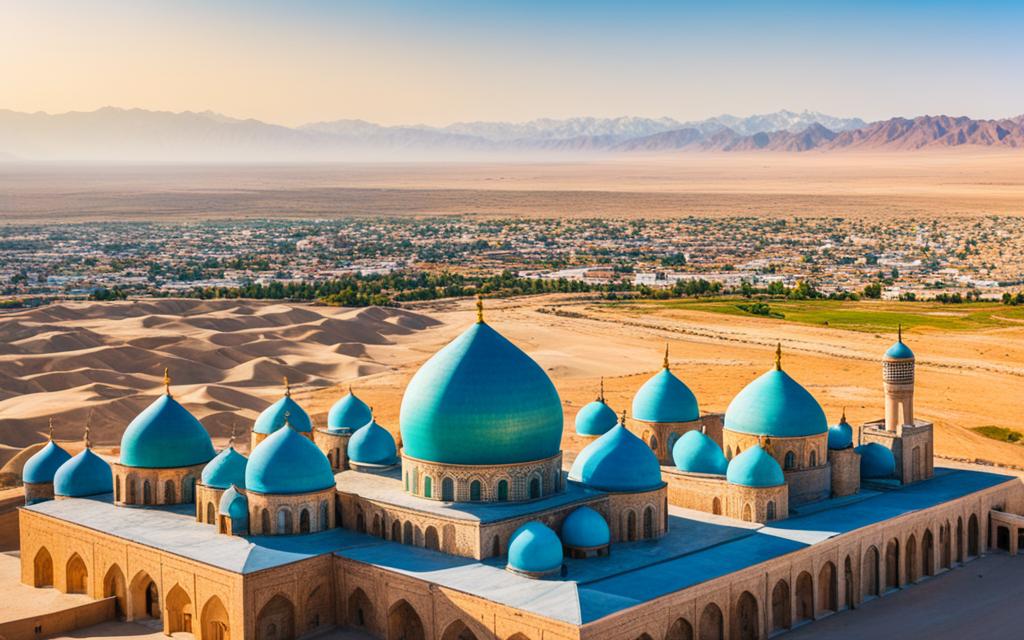
The Vibrant Trade of Samarkand on the Silk Road
In the heart of Uzbekistan lies the magnificent city of Samarkand, known for its vibrant trade and cultural significance along the ancient Silk Road. As goods from East and West passed through its bustling markets, Samarkand became a melting pot of diverse cultures and a hub for commercial activities.
Samarkand’s strategic location along the Silk Road made it an essential stop for merchants and travellers, fuelling its thriving trade networks. The city traded a wide range of goods, including silk, spices, precious metals, and exotic fruits from China, while also offering goods such as carpets, ceramics, and textiles from Persia and Central Asia.
“Samarkand was not only a thriving trade centre, but also a cultural crossroads where ideas, technologies, and arts were exchanged among different civilisations. It was a beacon of innovation and progress during the Silk Road era.”
The economic prosperity brought about by the trade on the Silk Road had a profound impact on the development of Samarkand. The city flourished under the patronage of various empires and rulers, resulting in the construction of magnificent architectural masterpieces that still stand today.
The Architectural Wonders of Samarkand
Samarkand boasts numerous architectural wonders that showcase the city’s rich history and cultural heritage. The Registan Square, with its three grand madrasas adorned with intricate tilework and majestic portals, stands as a testament to the grandeur of Samarkand’s past. The Bibi-Khanym Mosque, a marvel of medieval architecture, captivates visitors with its massive turquoise dome and intricate mosaic patterns.
The city’s architectural heritage extends beyond religious structures. The Shah-i-Zinda necropolis, an avenue of mausoleums and tombs, showcases stunning tilework and intricate Islamic geometric designs. The Ulugh Beg Observatory, built by the Timurid ruler Ulugh Beg, stands as an ancient testament to the city’s scientific achievements.
To fully grasp the essence of Samarkand’s vibrant trade on the Silk Road, a visit to the Siyob Bazaar is essential. Here, amidst the colourful stalls and bustling crowds, you can experience the lively atmosphere reminiscent of the city’s trading heyday.
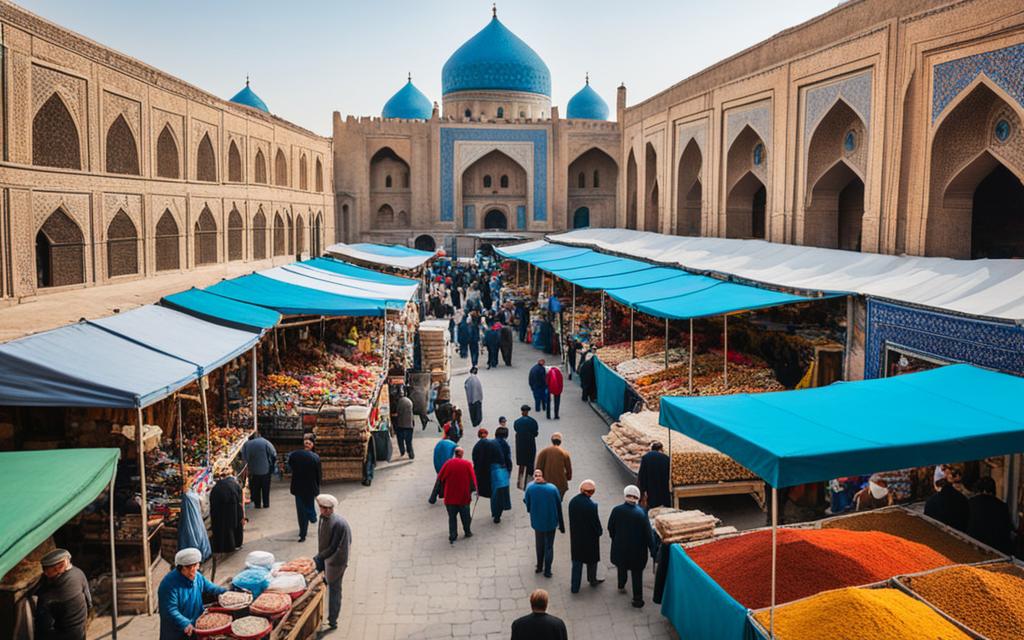
| Trade Goods | Origin | Destination |
|---|---|---|
| Silk | China | Europe |
| Spices | India | Middle East |
| Precious Metals | Central Asia | Europe |
| Exotic Fruits | China | Middle East |
| Carpets | Persia | Europe |
| Ceramics | Central Asia | Middle East |
| Textiles | Persia | Middle East |
The trade routes of the Silk Road played a pivotal role in shaping the history and culture of Samarkand. Through the exchange of goods, ideas, and technologies, the city became a beacon of prosperity and innovation, leaving an indelible mark on the region.
As you explore the enchanting city of Samarkand, marvel at its architectural wonders and soak in the vibrant atmosphere, you will truly understand the significance of its trade on the Silk Road and its enduring legacy.
Immerse in the Cultural Heritage of Uzbekistan
Uzbekistan, situated along the historic Silk Road, boasts a wealth of cultural heritage that is waiting to be discovered. Embarking on a railway holiday through this enchanting country provides an unparalleled opportunity to immerse yourself in its diverse traditions, arts, and cuisine. Let’s delve into the vibrant culture of Uzbekistan and explore ways to fully experience and appreciate its rich heritage.
One of the remarkable aspects of Uzbekistan’s cultural heritage is its fusion of influences from various civilisations that traversed the Silk Road. Over centuries, the region has been shaped by interactions with Persian, Arab, Turkic, and Russian cultures, resulting in a unique blend of traditions and customs.
Begin your cultural journey in the ancient city of Bukhara, known for its well-preserved historical sites and architectural wonders. Walk through the narrow streets of the old town, lined with stunning buildings adorned with vibrant blue tiles, and revel in the ambience of a bygone era. Visit the majestic Kalyan Mosque and the awe-inspiring Ark of Bukhara, steeped in legends and stories of the Silk Road era.
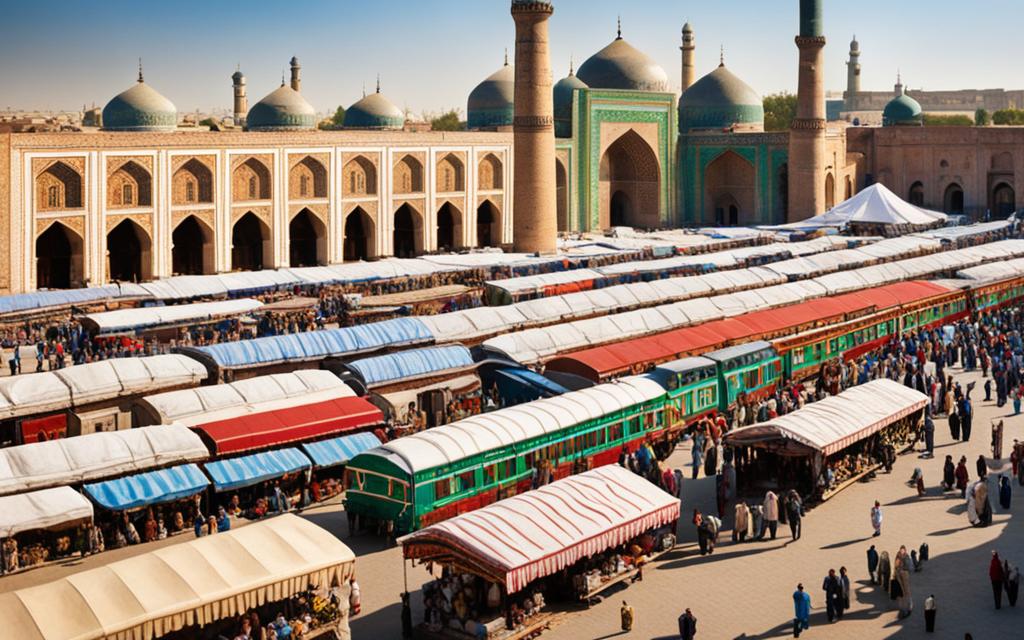
Continue your exploration in Samarkand, a city that once served as a bustling trade hub on the Silk Road. Marvel at the grandeur of Registan Square, featuring three magnificent madrasahs adorned with intricate tilework and stunning Islamic architecture. Take a stroll through Bibi-Khanym Mosque, an architectural masterpiece, and immerse yourself in the tales of traders and merchants who once converged here.
To truly immerse yourself in Uzbekistan’s cultural heritage, engage in the art forms that have been passed down through generations. Attend traditional music performances that showcase the hypnotic sounds of the dombra and the soulful melodies of maqom, evoking the spirit of the Silk Road. Learn the art of silk weaving from local artisans, who skillfully create intricate patterns using age-old techniques.
Indulge your taste buds in the flavours of Uzbek cuisine, which epitomises the country’s cultural heritage. Savour the melt-in-your-mouth flavours of plov, a fragrant pilaf dish made with rice and succulent meat, or delight in the delicate layers of flaky pastry in traditional Uzbek pastries. The culinary journey along the Silk Road in Uzbekistan is a true feast for the senses.
As you traverse Uzbekistan’s cultural landscape, you’ll also encounter the warm hospitality of its people. Engage in conversations with locals, who are eager to share their stories and traditions with visitors. Take part in traditional dance and crafts workshops, where you can learn to create intricate embroidery or master the graceful movements of Uzbek dance.
By immersing yourself in the cultural heritage of Uzbekistan, you’ll gain a deeper appreciation for the historical significance of the Silk Road and the enduring legacy it has left behind. Whether it’s exploring ancient cities, enjoying traditional performances, or indulging in local cuisine, every aspect of your journey will unveil the rich tapestry of Uzbekistan’s cultural heritage.
Must-Visit Sites along the Silk Road in Uzbekistan
As you embark on your journey along the Silk Road in Uzbekistan, there are several must-visit sites that will transport you back in time and leave you in awe of the country’s rich history and cultural heritage. From ancient cities steeped in legends to breathtaking landscapes, these destinations offer a glimpse into the vibrant past of the Silk Road.
1. Samarkand
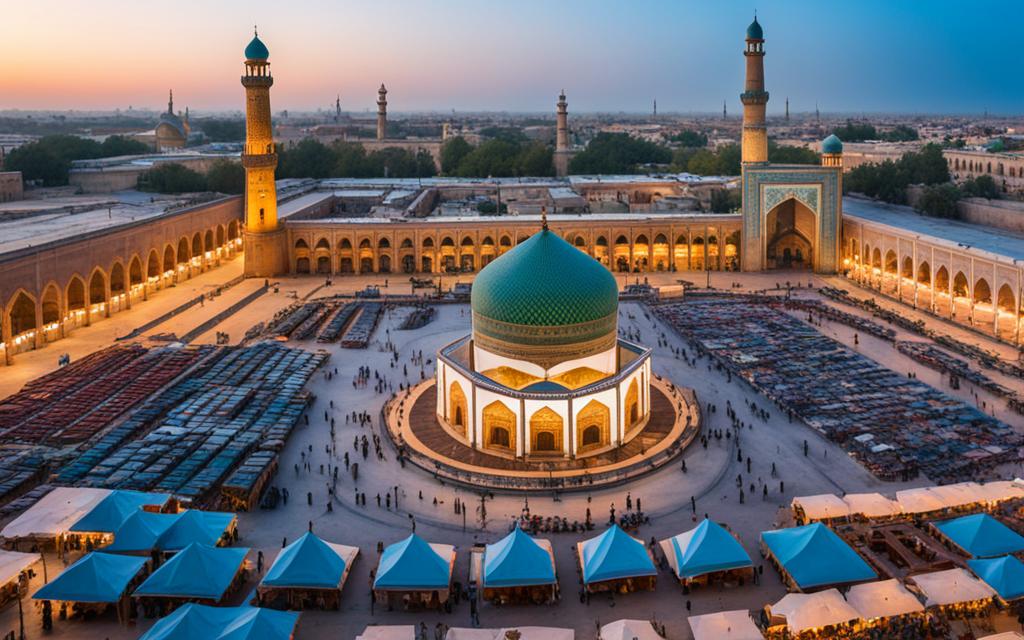
Known as the “Pearl of the East,” Samarkand is a city that has captivated travellers for centuries. It was a bustling centre of trade along the Silk Road and is home to architectural marvels such as the Registan Square and the Bibi-Khanym Mosque. Marvel at the intricate tilework and grandeur of these ancient structures as you explore the city’s rich history.
2. Bukhara
Bukhara is a city that has preserved its medieval atmosphere, making it a treasure trove for history enthusiasts. Explore the UNESCO World Heritage-listed historic centre, where you’ll find stunning landmarks like the Kalyan Minaret and the Samanid Mausoleum. Stroll through the narrow streets of the old town, lined with traditional houses and bustling bazaars, and immerse yourself in the city’s vibrant culture.
3. Khiva
Step into a living museum as you visit Khiva, a perfectly preserved ancient city. Wander through the labyrinthine streets of the Itchan Kala fortress, marvel at the exquisitely decorated mosques and palaces, and soak in the atmosphere of this UNESCO World Heritage site. Khiva’s well-preserved architecture will transport you back in time, offering a glimpse into the prosperous days of the Silk Road.
Aside from these ancient cities, the Silk Road in Uzbekistan also showcases stunning natural landscapes that are a feast for the eyes:
4. The Aral Sea
Despite its ecological challenges in recent years, the Aral Sea remains a hauntingly beautiful sight. Witness the striking contrast between the vast, desolate seabed and the surrounding desert landscape. The remnants of abandoned ships serve as a reminder of the sea’s former glory, creating a unique and poignant atmosphere.
5. The Nuratau-Kyzylkum Biosphere Reserve
Escape the bustling cities and immerse yourself in the serene beauty of the Nuratau-Kyzylkum Biosphere Reserve. This protected area is home to diverse wildlife, including eagles, ibex, and wild boars. Spend a day exploring the breathtaking landscapes, from rugged mountains to lush valleys, and experience the tranquillity of nature.
These are just a few of the many must-visit sites along the Silk Road in Uzbekistan. Each destination offers a unique experience and a deeper understanding of the historical significance and cultural heritage of the region. So, pack your bags and set off on a journey that will transport you back in time along this ancient trade route.
Conclusion
As we come to the end of this post, we sincerely hope that we have sparked your interest in embarking on an enchanting journey along the Silk Road in Uzbekistan. The country’s rich history, captivating cities, and vibrant culture make it an ideal destination for a remarkable railway holiday.
By exploring ancient Silk Road cities like Samarkand, you will have the opportunity to delve into their extraordinary architectural wonders and immerse yourself in their cultural heritage. From the vibrant trade of Samarkand to the diverse traditions, arts, and cuisine of Uzbekistan, there is an abundance of experiences waiting to be discovered.
So, start planning your trip today and prepare to be captivated by the wonders of the Silk Road in Uzbekistan. Whether you are an adventure seeker, a history enthusiast, or simply looking to indulge in the beauty of a different culture, this remarkable journey promises to leave you with memories that will last a lifetime. Embrace the allure of the Silk Road and embark on a railway holiday like no other.
FAQ
What is the Silk Road Uzbekistan railway?
The Silk Road Uzbekistan railway is a historic railway route that follows the ancient Silk Road trade route through Uzbekistan. It allows travellers to experience the rich history and cultural heritage of the region.
What are some holiday ideas for the Silk Road Uzbekistan Railway?
There are several ideas for the Silk Road City Uzbekistan railway holiday. You can explore ancient cities, visit historic sites, experience local culture and cuisine, and marvel at stunning landscapes along the route.
Which ancient cities can be explored on the Silk Road in Uzbekistan?
Some of the ancient cities that can be explored on the Silk Road in Uzbekistan include Samarkand, Bukhara, Khiva, and Tashkent. These cities have a rich history and offer unique architectural wonders and cultural experiences.
What did Samarkand trade on the Silk Road?
Samarkand was a major trading hub on the Silk Road and traded various goods such as silk, spices, precious stones, ceramics, and textiles. Its strategic location facilitated the exchange of goods between East and West.
What is the cultural heritage of Uzbekistan?
Uzbekistan has a rich cultural heritage, with influences from Persia, Central Asia, and the Islamic world. Traditional arts, crafts, music, dance, and cuisine are integral parts of Uzbek culture, and exploring them is a memorable experience on the Silk Road journey.
What are some must-visit sites along the Silk Road in Uzbekistan?
Some must-visit sites along the Silk Road city in modern Uzbekistan include Registan Square in Samarkand, the Ark Fortress in Bukhara, Itchan Kala in Khiva, and the Gur-e-Amir mausoleum. These sites showcase the architectural beauty and historical significance of the region.
You may also like
-
Ladies Fashion: Why Are Your Peers Buying Vintage Rolex?
-
How to Get Rid of Your Old Car for Free: Exploring Your Options in Australia
-
Explore Trains for Europe: Your Gateway to Adventure
-
Get Your Tourist Visa for China: A Comprehensive Guide For UK Travellers
-
Why A Cute Short Homecoming Dress Is Perfect For You

